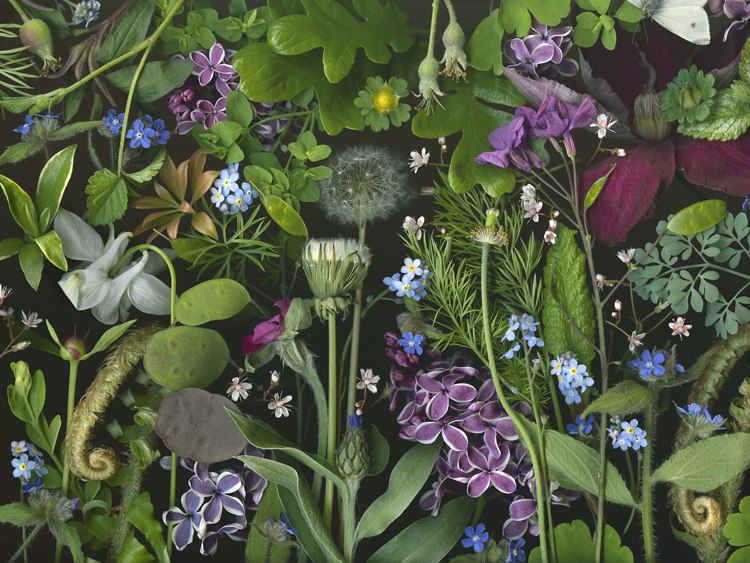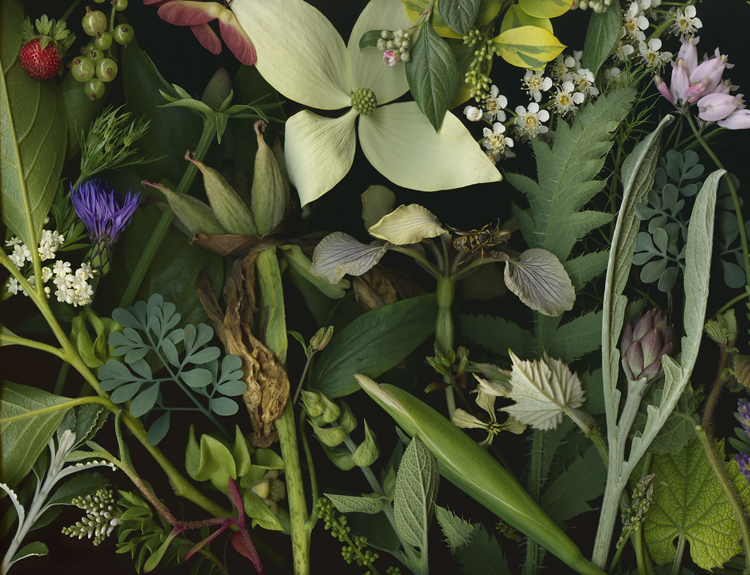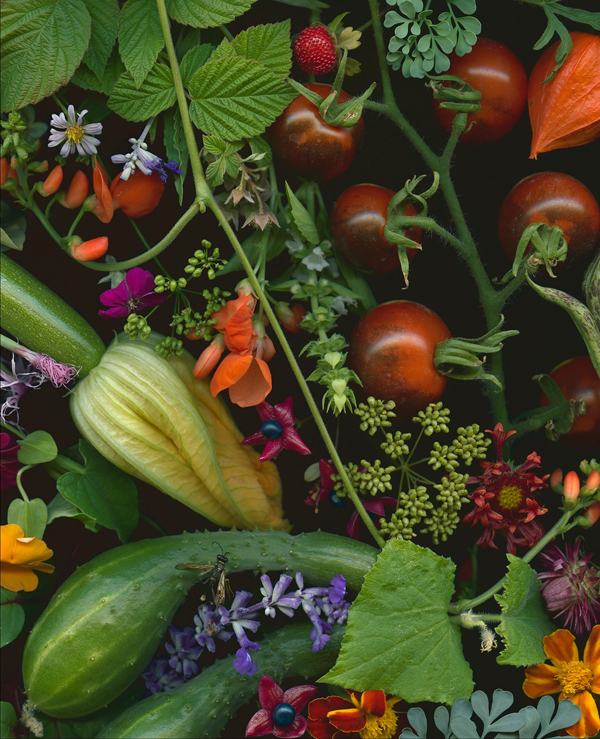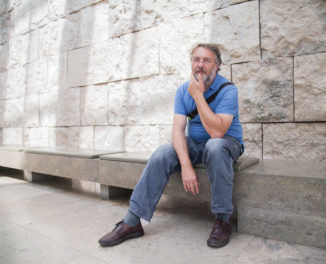Deb Stoner is a Portland jewelry maker and eyewear designer turned still-life photographer. She’s lived, worked, and studied in California—when she first visited the Getty years ago, she took home a poster of the Central Garden that’s since inspired countless photographs.
She revels in the wonders of nature, capturing unique plants and insects within her work. One such plant, a spiky evergreen shrub known as the “porcupine tomato” (Solanum pyracanthum), has appeared in many of Deb’s photos. It’s also the plant that motivated Deb to create her stunning #GettyInspired flora and fauna images.

Spiky leaves of Solanum pyracanthum at left. Image here and below courtesy of and © Deb Stoner
Allison Ramirez: How did you get started as a photographer?
Deb Stoner: There were two boxes of photos kept in my parents’ bathroom that I was obsessed with in my teens. My dad had bought a Rolicord when he was stationed in Iceland during the Korean War, and those pictures he took—black and white, square format, ordinary scenes of everyday life as an Air Force radio technician—fascinated me. The other box was filled with my mom’s high school graduation pictures, all 25 students from her class of 1955, hand-painted. Really lovely.
My other photographic influence at that time was Bill Owens. I grew up in Livermore, and he was the photographer for our town’s newspaper. Growing up, his view on Suburbia, the book made of his photographs during the early 1970s, that was my life, my classmates’ lives, my neighbors and friends, and that was my photographic education.
When I bought my first camera in 1976, I was a geology student working for the Forest Service in Northern California, and I took pictures of trees, sunsets, flowers, deer in headlights, dogs. Cat pictures, apparently, hadn’t yet been invented, and selfies were quite unusual.
I learned darkroom work from about three lessons with a friend at UC Davis and from that point on, I was never far from a camera or a darkroom. I shot slides when I traveled, black and white when I was feeling creative. In grad school at San Diego State University in the late 1980s, I was studying jewelry and metals, but fell in with a fun group of photographers united by our love of the desert and the unique eye of my dearly departed professor, who liked to find stuff in the desert to shoot. He also liked to build stuff and photograph it, and I think that was my first appreciation of the genre of still life, art made from arranged and composed objects and ideas. When he was making art, he wasn’t afraid of style. Or design. Or beauty.
Tell me about your #GettyInspired images and that story. It’s wonderful that we’re able to find inspiration in so many places, isn’t it?
The Solanum pyracanthum images are part of long-term project of making still life photographs of the flora and fauna of my backyard. I’ve extended the reach to neighbors’ yards, and the fauna to include more exotic species, but the format is consistently very large-scale images that allow the viewer immersion in a world that is usually quite miniature.

What is it about art and nature that inspires you?
When I was in grad school in San Diego, the Getty was being built, and there were lots of students very in awe of Robert Irwin’s work with light, and grad seminars were buzzing with his ideas. When I finally got to see the Getty garden, the azaleas were in bloom, and although stunned by their beauty, I didn’t know enough about their growing habits to be stunned that they existed in Los Angeles at all. I lived in Portland at that point, and azaleas are everywhere here. No big deal.
When I settled down and bought a house, my husband was very into gardening, so we dug and amended and planted and harvested. One year, we wanted to document some of the crazy hybrid marigolds that we were growing from seeds that we saved each year. As I photographed the specimens, I got interested in creating compositions with other flowers, along with my insect collections, and all of a sudden, I was solidly immersed in the world of still life. Not so far, really, from the miniature world of the jewelry pieces I’d been known for. Then, once the ability to print very large in high resolution became a possibility, that became my thing.

The excellent thing about creating art utilizing the stuff of nature is the continuous ability to be in awe, to be surprised and excited and thrilled by what are actually everyday events. Like learning about the life cycle of the cabbage moth because my husband found a chrysalis and put it on a plate, and days later, we happened upon it as it started to wiggle its way out, marveling as we watched its wings unfurl, getting ready to fly. Nature provides me with the inspiration and the stuff to make art from.
What’s the art/photography scene like in Oregon, as opposed to California?
When I moved to Oregon in the late 1980s, I was intrigued by the wet green landscape, so I photographed my surroundings. It seems like photography has always served me as a way to look closely at new things, to understand the world around me. Coming from the big sky country of Southern California, Oregon seemed to have clouds instead of sky, trees instead of land, and I didn’t know what to make of it until I started paying attention to the images I made.
I think regional differences are dissolving as digital tools make the world smaller. Photographers everywhere are making amazing images, and continue to evolve as new tools are offered up daily. I can tell you that our Multnomah County library system may be the best in the world, and has fed me a constant stream of amazing books on photography, with the best published by Getty Publications. The scholarship made accessible by Getty authors Paul Martineau, Anne Woollett, and Weston Naef, among many others, has informed and inspired my work for many years.

What are you working on now?
A project that involves getting to know my neighbors in a different way. I’ve asked for access to their gardens, and so, when I show up with my little basket and clippers, they know I’m just gathering art supplies in the form of their amazing specimens. What I’ve learned about gardeners is that they love to show off what they grow, and are so generous in offering information.
Springtime in Portland is pretty overwhelming if one is inclined to trying to photograph all the changes of plant life in a neighborhood, but I really am having fun right now, and meeting some marvelous folks. Hot tips on blooming trilliums and fritillaria are very gratefully received!
What’s it like being a photographer with a background in jewelry and eyewear design? How has this helped your process?
Since my “real” work was in jewelry and eyewear design, I’ve always felt very free as a photographer to go in any direction I want. Now I feel I’ve found my stride in the work I’m doing as a photographer, working with the culmination of ideas from a long life immersed in art and craft. I try for one obsession at a time, but that’s tough.
See more of Deb’s striking photos at debstoner.com.

See all posts in this series »





Wonderful article and gorgeous work. I would love to see large scale prints of these pictures hanging in a hall at the Getty!
Never before have we seen our gardens buds and blooms so magically posed as in these portraits that Deb captures. Just wow.
Deb,
Your eye to look above and below into the world of nature’s beauty is amazing. I want you to come to Berkeley, CA to gaze your eyes of the jewels of our garden. It’s a special place to be at peace with oneself and the world no matter what is happening. Just “looking” as I have called it, reveal the secrets of nature and art thru your amazing translation of hand and eye coordination. This interpretation goes from something being worn as jewelry or just glazing your eyes for a moment or a frame jewel of photography in ones living environment. Keep up the great work!
Cheers, Vernon & Gennady
These are so lovely, Deb. What a fantastic new direction for you. Proud to know you! each day I wear one of the many pairs of earrings that you made for me.xxoo